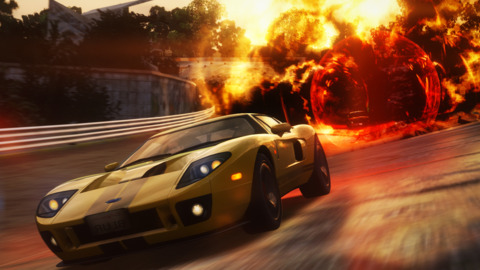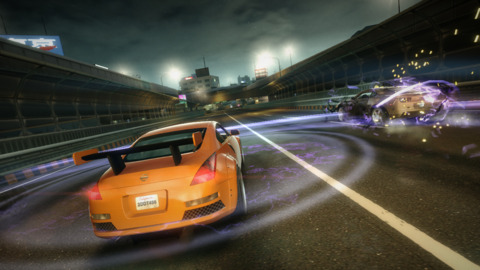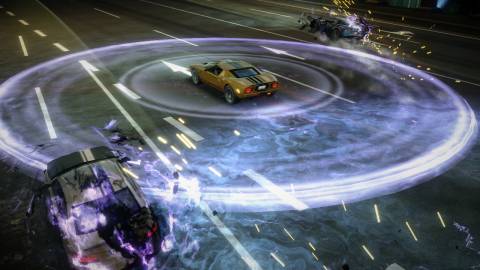
If you've played one of Bizarre Creations' past racing games, you'll be coming into Blur with a pretty good idea of how the cars will handle. BC has rarely aimed for 100% simulation-style authenticity with its racing games, but Blur steers well clear of any arcade-style comparisons simply by demanding that you not barrel full-throttle into ever turn, expecting to effortlessly drift your way through. You'll (hopefully) learn early that such behavior will almost invariably end in a disappointing spin-out, and that each car has a fairly specific handling profile. There are multiple classes of cars, but it's not always a clear-cut case of better-than/worse-than, with some flourishing on the game's slippery dirt tracks, while others are better equipped for the narrow urban corridors and hard turns of the street courses. There's just a huge number of cars in Blur, and they cover a wide range of makes, models, and vintages, from high-whining European super-cars to knobby-tired 4x4 off-roaders. Cars will occasionally bump awkwardly up into the air upon impact, and there can be some squirreliness when you don't expect it, but there's a general sense of sturdiness to the core driving in Blur.

Most of the offensive weapons will at least slow you down and do some damage that, if allowed to go unchecked, will leave you a smoldering wreck, at least for a few precious seconds while you wait for a new car to spawn. But what makes the power-up system in Blur so strategically interesting is the way you can counter most offensive attacks with other offensives or alternate fires. If someone locks onto you with a shunt, you can fire a shunt or a series of bolts back, drop a mine, or trigger a barge to neutralize it. It's a system that requires good situational awareness, smart power-up management, and a firm understanding of the rock-paper-scissors-lizard-Spock dynamics of the power-ups, and it's responsible for much of Blur's chaotic charm. Exacerbating that chaos is the fact that Blur tends to trade in high-volume races, often putting twenty cars on the track at once. This can make the first lap particularly volatile, but the power-ups ensure that you're bound to experience hard swings in any lap.

But really, what pulled me away from the career was the draw of Blur's online multiplayer, which adopts the increasingly familiar carrot-on-a-stick persistence popularized by Modern Warfare, rewarding you with access to new cars, performance-enhancing mods, and different online playlists for your performance. The beauty of this, and what sets it so far apart from the single-player game, is that you don't need to win every race to earn experience towards your rank--heck, you don't even have to place, so long as you drive with a little panache and make smart, or at least frequent use of the power-up system. There are a hundred little ways that you can earn points towards your rank, and I found regular satisfaction finishing in the middle of the pack, but still cashing in plenty of points from some performance-based challenge. It took me a good six hours of time logged in the multiplayer to climb about halfway up the online ranking system, though I get the sense that your progression grows exponentially slower with each additional level.
I suppose it's also worth mentioning that Blur is the most socially networked game I've personally seen, with hooks for both Facebook and Twitter, allowing you to bug the everliving hell out of your friends and followers with weird automated messages. It's kind of dumb, and it's all completely optional, though it seems like a portent of bad things to come in other, future games. What makes the social underpinnings of Blur meaningful, though, is the way it lets you tag a buddy as your arch rival, adding the objective of beating their performance in specific races.
If you step back and look at the parts, there's a weird dissonance to Blur, and it doesn't seem like it should work as well as it does, even if it can be an imperfect experience. Bizarre Creations has always danced along the line between simulation and style, and this game only serves to further blur that line.